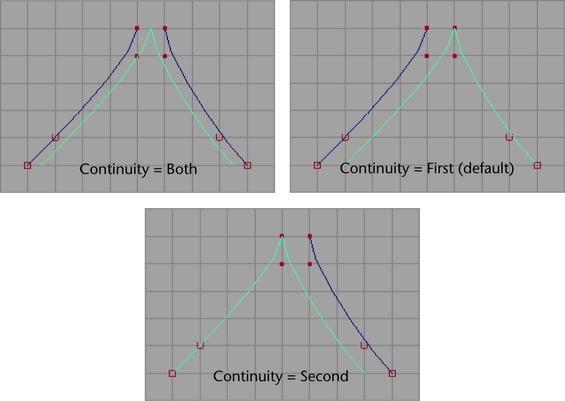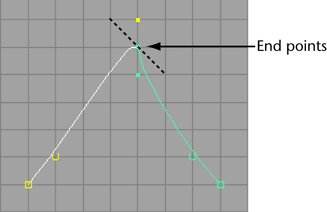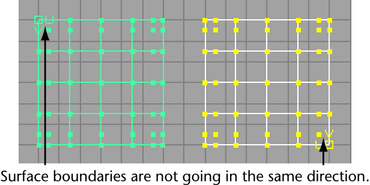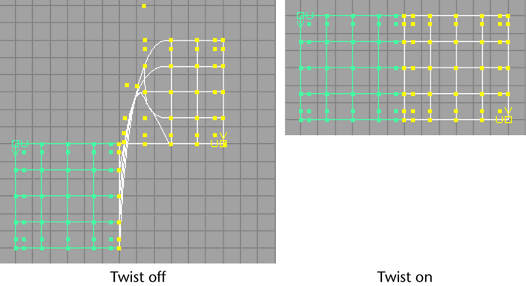Makes the
edges of surfaces tangent or curvature continuous.
Edit NURBS > Align
Surfaces > 
- Attach
-
Select Attach if
you want to attach the surfaces as well as align.
- Multiple Knots
-
When
objects are joined, Multiple Knots are created
at the Join Parameter. Select Keep to retain
these knots.
Select Remove to
remove as many knots as possible without changing the shape of the object
when the attach is performed.
- Continuity
-
Continuity means
that two surfaces share a boundary. Continuity options
let you specify how to achieve continuity for the two surfaces.
Positional
continuity means that the ends of two surfaces meet exactly. The
following figure shows a side view of how surfaces are aligned with
each Modify Position option (First, Second, and Both).
The alignment occurs depending on which surface is selected first
(white) and last (green).
Tangent continuity
exists when two surfaces are placed end to end, and the tangents
at the endpoints also match. An example side view of aligned surfaces
follows:
Curvature continuity
exists when two surfaces that meet with tangent continuity also
have the same curvature at the joint. When this option is selected,
the curvature scale sliders are enabled.
- Modify Position, Modify
Boundary, Modify Tangent
-
You can choose the order
you want the surface modified. The following tables show what is modified
with the different Modify options.
| Modify Position |
Surfaces |
First Only the shape of the
first surface you select is modified.
|
The entire first surface
moves so its end boundary coincides with the start boundary of the
second surface. Some adjustments are made to the first surface end
boundary CVs.
|
Second Only the shape of the
second surface you select is modified.
|
The entire second surface
moves so its start boundary coincides with the end boundary of the
first surface. Some adjustments are made to the second surface start
boundary CVs.
|
Both The shapes of both the
first and second surfaces you select are modified.
|
The entire first and
second surfaces move so that the end boundary of the first surface
and the start boundary of the second surface coincide. The adjacent boundary
CVs move halfway along the line of minimum distance.
|
| Modify Boundary |
Surfaces |
First Only the shape of the
first surface you select is modified.
|
All the end boundary
CVs of the first surface move to coincide with the adjacent start
boundary CVs of the second surface.
|
Second Only the shape of the
second surface you select is modified.
|
All the start boundary
CVs of the second surface move to coincide with the adjacent end
boundary CVs of the first surface.
|
Both The shapes of both the
first and second surfaces you select are modified.
|
All the end boundary
CVs of the first surface and the start boundary CVs of the second
surface move to coincide with each other. The adjacent CVs move
halfway along the line of minimum distance.
|
| Modify Tangent |
Surfaces |
First Only the shape of the
first surface you select is modified.
|
The tangents at the end
boundary of the first surface adjust to coincide with the tangents
at the start boundary of the second surface.
|
Second Only the shape of the
second surface you select is modified.
|
The tangents at the start
boundary of the second surface adjust to coincide with the tangents
at the end boundary of the first surface.
|
NoteCurvature continuity
is applied to the surface that is modified for tangent continuity
(see the table above).
- Tangent Scale, Curvature
Scale
-
The
values in the Tangent Scale and Curvature Scale boxes
increase or decrease the tangent magnitude or curvature at the end
of the surface. You can enter a value in the box or drag the slider
bar. The following table shows what happens when the tangent and
curvature is scaled.
| Tangent Scale |
Surfaces |
First Only the shape of the
first surface you select is scaled.
|
The tangent magnitude
at the end boundary of the first surface adjusts.
|
Second Only the shape of the
second surface you select is scaled.
|
The tangent magnitude
at the start boundary of the second surface adjusts.
|
| Curvature Scale |
Surfaces |
First Only the shape of the
first surface you select is scaled.
|
The curvature at the
end boundary of the first surface adjusts.
|
Second Only the shape of the
second surface you select is scaled.
|
The curvature at the
start boundary of the second surface adjusts.
|
- Keep Originals
-
If Keep
Originals is off, the original surfaces are replaced
with the aligned surfaces. If on, two new surfaces are created and
the originals are retained.
- Input Surface
-
The Input
Surface information is read-only. It gives you access
to the history of the surfaces you aligned. Click the arrow buttons
to select an input surface and open its section of the editor.
- Join Parameter
-
The Join
Parameter slider becomes available depending on the Positional
Continuity Type you select. Use Join
Parameter to define the parameter on the first/second
surface at which the alignment is performed.
- Reverse/Swap
-
The Reverse and Swap options
for surfaces define whether the surfaces have to be reversed and
or swapped before performing the alignment (remember, align uses
the end of the first surface and the start of the second). The reverse
is done in the direction defined by Direction U (on
or off) in the Channel Box.
- Twist
-
If Twist is
turned on, the second surface is also reversed in the opposite direction
of Direction U. Turn this on if
your aligned surface is twisted.
For example, if you align
the surfaces and the surface boundaries are going in different directions,
the following results.
When you select the surfaces,
the align result is twisted. Turn Twist on
either from the Attribute Editor or in the Channel
Box to correct the problem.
The other alternative
is to check the surface U/V direction before you align the surfaces.
Use
Edit NURBS > Reverse Surface Direction to
reverse the surface directions if necessary.
NoteAlign
Surfaces computes the twist values for edges, so you
do not need to align surfaces then turn on the twist attribute to
get a clean join.
- Interior Blending
-
The
Interior Blending sections are
the same as the Tangent Scale options in the
options window. The sliders become available depending on which
type of continuity you select.




